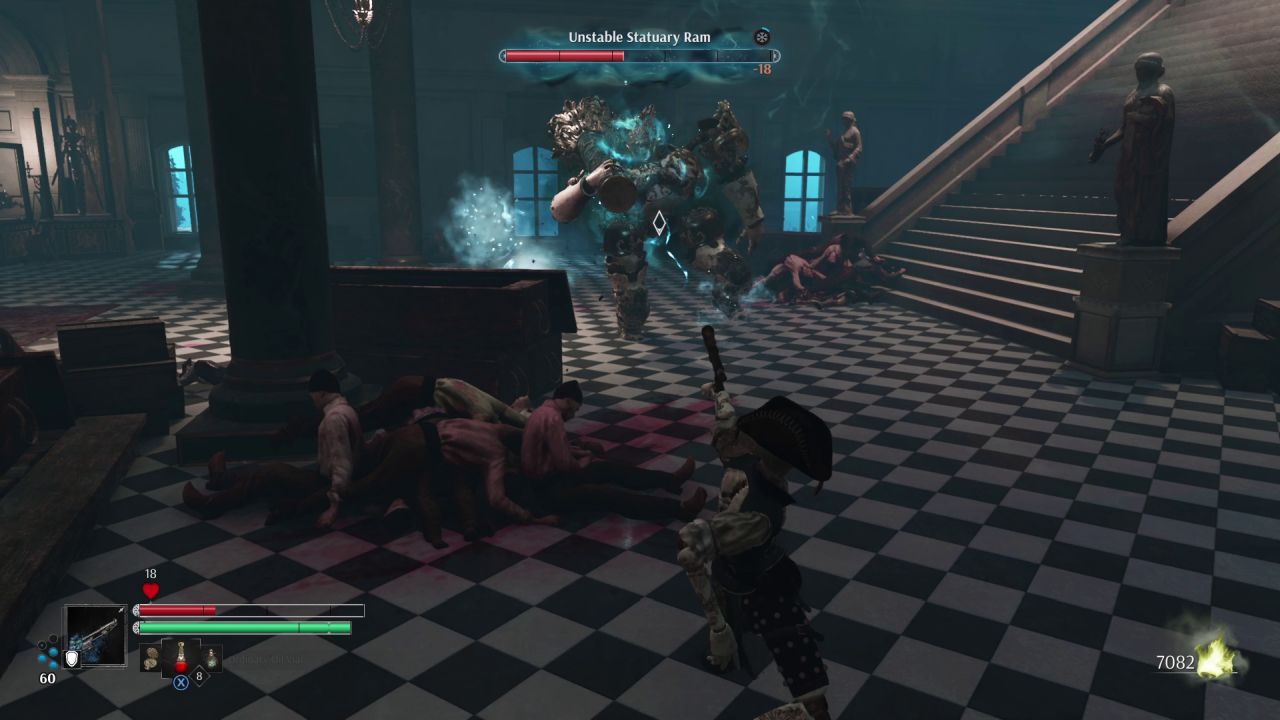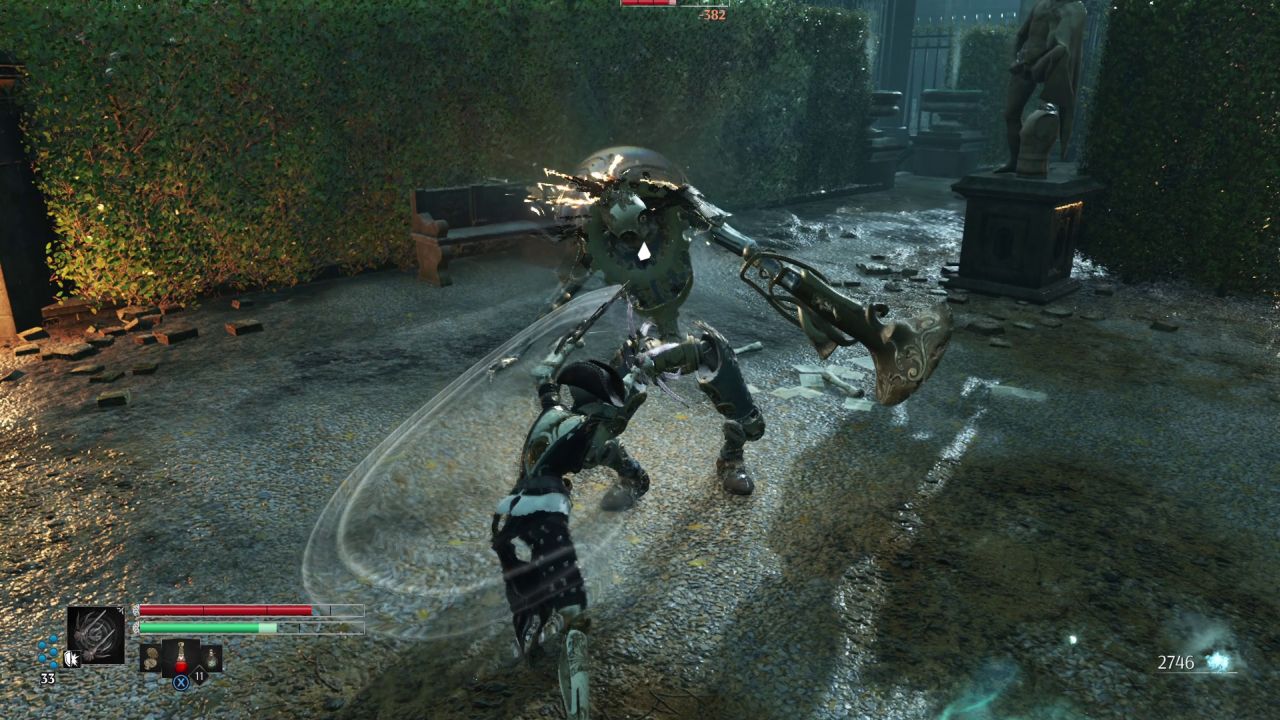This takes some doing, but luckily Aegis is a very advanced robot, the bestest of all the robots. Slight but adaptive with it, and even having an advanced AI, Aegis can carve a swift path through the more than usually twisted metal in her way. It’s a bit too easy, in fact. Steelrising has eight levels, comprising different areas in and around Paris. It’s not an intricate and fully connected world like in a Souls game proper, but the levels themselves are quite large, and have a few doors you can only open from the other side to create shortcuts, that kind of thing. You get to run around a few of the Parisian tourist hits as you go, too - the Louvre palace, pre-art gallerying! The banks of the Seine! Ooh, is that Notre Dame on the skyline? This being during a swiftly-quashed revolution, however, means that Paris is in a state of fun ruin. Streets are blocked by hastily-erected barricades, carriages on fire, or, depending on where you are, just some big lumps of topiary that have fallen over. After a few hours, and killing a few big bosses, Aegis gets extra abilities that expand her traversal options. There’s a sort of long jump to get over big gaps, a mini-battering ram to get through weak doors and walls, and a grappling hook to hoy up to far-off ledges. This opens levels up further; you might remember a wall that blocked you early on in the first level, and think, “Well, I wonder what’s behind there?” The other barriers to your progress are, of course, all the bad robots. The automata were originally designed to do all sorts of labour, so as well as guards there are things like lumberjacks, butchers and musicians that have all become very aggressive, often with a secondary elemental attack of fire, ice or lighting. I enjoyed the enemies very much, because you can see how they started off designed for specific tasks. There’s one that appears to be either a gardener or lamp-lighter thing that is basically a snake with swords stuck all over it. It has a nasty habit of hiding on walls and landing on you like an absolute bastard. Some of the big bosses are tremendous fun as well. Every so often you get a mini-boss who then starts turning up as a regular enemy, but there are several huge main mega-bosses. My favourite was basically a very sarcastically-designed bishop’s mitre rolling around on a buzz-saw. It even held a bible and had a tiny little bishop figurine as a head. Top work. There’s some leeway in how you go at these lads as well. Aegis has some different potential original designs, aka: classes (I chose “Dancer”, which made me less strong but quicker and with more stun power, but you could be a warrior, or a wizard-esque elementalist), as well as some fun weapons to choose from. There are light, medium and heavy weapons, each with a secondary move or special attack, and two slots, so you you can spec with a heavy melee weapon and an ranged one, for example. There are big heavy metal wheels, a fire chain whip, a scroll on a stick that becomes a massive shield, the bladed fans, maces, dual swords, halberds… They feel different, and suit different styles. I spent most of the game with knife arms that were quick but had no block funtion, and gun arms that fired frost bullets. And the problem was that I became basically unstoppable. There are a few things to hold you back in combat. There’s a stamina bar (explained as you overheating), elemental status effects can really screw you up, and proper blocking takes some skill. The auto-lock in combat does make things unintentionally a lot more difficult in situations with multiple enemies, because it flicks between targets when you don’t want it to move and sticks when you do. Despite this, though, I spent most of Steelrising feeling overpowered. Every boss, even the big titans, took me two goes tops: once to fail but learn the attack patterns, and then another to kill it. I specced to move fast and stun hard, so I could constantly perform finisher moves and special attacks. I rarely used the consumables, I never needed to grind to level up, and if I died it was usually from being sloppy or frustrated. I couldn’t tell you places that are good for grinding in Steelrising anyway. I found the levels, while fun to look at, to be inconsistent. There are long stretches with no enemies at all, while other areas are stacked. You level Aegis at Vestal shrines, where you can upgrade weapons, abilities and module slots (where you can slot in new firmware to make you better, faster, stronger), but you can’t travel between them like with Dark Souls bonfires, and their placement is sometimes weird. They’re also too easy to miss, because until you activate them they look like statues, and there are a lot of statues in this game. And because you can’t travel between them, it discourages exploration. There are a bunch of secrets to find, and some genuinely cool bits to explore in Steelrising, but if you go off the beaten track and die you might end up respawning at a Vestal point miles from your objective, and with no option but to slog through the same load of sewers that you now regret being curious about. It’s frustrating not just as a play experience, but because things like this also feel like Steelrising’s getting in its own way when it doesn’t need to. For every peak where you realise you’ve cracked the attack pattern of the annoying enemy robot with maces for hands, there’s a trough where you find a door that won’t open but feels like it should, or get lost in a formal garden for five minutes because it’s indistinguishable from the three other formal gardens you’ve just fought through. And the things you should be thinking about in a Soulslike - learning the map; bosses tough enough to destroy your will to live; absolute precision in your attacks - don’t really need to be considered. Despite the story and side missions being interesting enough to make you want to finish Steelrising (and they are), despite the world being pretty-ugly (and it is), despite the combat having the ingredients to be interesting and cool (and it does), you still might end up annoyed and a bit bored by it all. And it’s worse because it’s so almost better than that.



